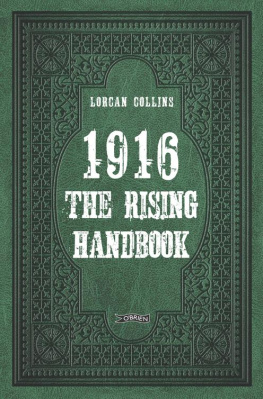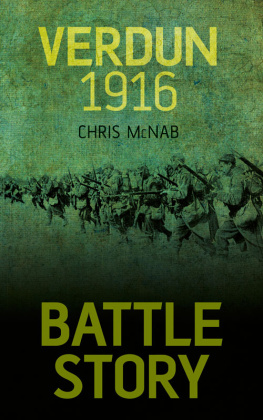Benoît Chenu - 1916 - The Battle of the Five Empires: 15 May - 28 September 1916
Here you can read online Benoît Chenu - 1916 - The Battle of the Five Empires: 15 May - 28 September 1916 full text of the book (entire story) in english for free. Download pdf and epub, get meaning, cover and reviews about this ebook. genre: History. Description of the work, (preface) as well as reviews are available. Best literature library LitArk.com created for fans of good reading and offers a wide selection of genres:
Romance novel
Science fiction
Adventure
Detective
Science
History
Home and family
Prose
Art
Politics
Computer
Non-fiction
Religion
Business
Children
Humor
Choose a favorite category and find really read worthwhile books. Enjoy immersion in the world of imagination, feel the emotions of the characters or learn something new for yourself, make an fascinating discovery.
- Book:1916 - The Battle of the Five Empires: 15 May - 28 September 1916
- Author:
- Genre:
- Rating:4 / 5
- Favourites:Add to favourites
- Your mark:
- 80
- 1
- 2
- 3
- 4
- 5
1916 - The Battle of the Five Empires: 15 May - 28 September 1916: summary, description and annotation
We offer to read an annotation, description, summary or preface (depends on what the author of the book "1916 - The Battle of the Five Empires: 15 May - 28 September 1916" wrote himself). If you haven't found the necessary information about the book — write in the comments, we will try to find it.
Benoît Chenu: author's other books
Who wrote 1916 - The Battle of the Five Empires: 15 May - 28 September 1916? Find out the surname, the name of the author of the book and a list of all author's works by series.
1916 - The Battle of the Five Empires: 15 May - 28 September 1916 — read online for free the complete book (whole text) full work
Below is the text of the book, divided by pages. System saving the place of the last page read, allows you to conveniently read the book "1916 - The Battle of the Five Empires: 15 May - 28 September 1916" online for free, without having to search again every time where you left off. Put a bookmark, and you can go to the page where you finished reading at any time.
Font size:
Interval:
Bookmark:
Translated from French
by Laurie Duboucheix-Saunders and Benot Chenu
ISBN 978-2-9585377-8-4 , Benot Chenu, Guche Publishing, Paris, 2022.
This publication is in copyright. Subject to statutory exception and to the provisions of relevant collective licencing agreements, no reproduction of any part may take place without the writtin permission of Benot Chenu.
Benot Chenu has no responsibility for the persistence or accuracy of URLs for external or third party internet websites referred to in this publication, and does not guarantee that any content on such websites is, or will remain, accurate or appropriate.
To Louis-Nol Chenu, my brother.
Light is sown for the righteous,
and joy for the upright in heart.
(Psalm 97:11)
The fault lies in the application at the onset of a flawed doctrine, an inaccurate assessment of the comparative state of the forces involved, an excessive timidity of the local command, and deficiencies within the higher command.
(General de Castelnau, chief of the general staff of the French Armies: Report on the wrong decisions made by the French high command on 3 July 1916 leading to the squandering of the opportunity for a great victory on the Somme)
I also owe many personal and professional debts to those who have provided support during the preparation and the writing of this book. I have already thanked some of them in the French edition. In this one, I would like to thank those without whom this English edition could not have come to be. Among them, I would in particular like to thank Bernard Giovanangeli and Damien Serieyx who never hesitated to embark on this adventure despite the risks involved. Without the contribution of Laurie Duboucheix-Saunders, this text would never have reached the high standards required for any quality publication. With her dual French-English culture and undeniable literary qualities, she has entirely revised this translation to make it suitable for the most demanding readers before copy-editing it. She was passionate about this work and brought much more to it than I expected. By doing me the honour of co-opting me into their prestigious association, the members of the British Military History Commission have also reinforced my motivation to be published in English. Last, I would like to remember the late Elisabeth Greenhalgh, who was the initiator of my previous book and who prefaced it. She has been by the same token at the origin of my career in military history.
DIFFERENT ASPECTS OF THE BRITISH CONTRIBUTION TO THE CONFLICT
ASPIRATIONS OF THE INDIVIDUAL BALKAN STATES
BULGARIAS GEOSTRATEGIC POSITION IN 1916
GERMAN WAR AIMS
LINKS BETWEEN THE CENTRAL POWERS IN 1916
LINKS BETWEEN THE ALLIED COUNTRIES OF THE ENTENTE IN 1916
THE SALONIKA CUL-DE-SAC
THE BATTLE OF VERDUN
SUBMARINE WARFARE
BATTLE OF VERDUN LEFT BANK
THE STRAFEXPEDITION THE PUNITIVE EXPEDITION 15 MAY 1916
THE EASTERN FRONT IN JUNE 1916
PLAN FOR THE BRUSILOV OFFENSIVE
TRANSFER OF THE GERMAN DIVISIONS
BATTLE OF VERDUN RIGHT BANK
GERMAN POSITIONS IN FRONT OF THE BRITISH FORCES
BATTLE OF THE SOMME - POSITION OF THE TROOPS
FRENCH POSITIONS SOUTH OF THE SOMME
BATTLE OF THE SOMME: FIRST ASSAULT 13 JULY 1916
BREAKTRHOUGH OF FRENCH SIX ARMY ON 3 JULY 1916
GERMAN REINFORCEMENTS AFTER THE 1 JULY ASSAULT
TWO OPTIONS IN CASE OF A BREAKTHROUGH INTO THE GERMAN DEFENSIVE SYSTEM
BRUSILOV OFFENSIVE 47 JULY 1916
STRATEGIC LOCATION OF ROMANIA
CONTEXT OF THE BRUSILOV OFFENSIVE
MANOEUVRE PROPOSED BY HAIG AND CASTELNAU
FRANCO-BRITISH EXPEDITIONARY FORCE IN JUNE 1916
TRANSFER OF THE GERMAN DIVISIONS AND CHANGES HEADCOUNTS JUNEAUGUST 1916
Les Armes Franaises dans la Grande Guerre (French Armies in the Great War) or AFGG: Published between 1922 and 1939, this collection of 107 books collected into eleven volumes was produced by the Service historique de larme, which was created in 1919 specifically for this editorial task. It includes accounts, documents and maps of the operations carried out by the French armies in 191418. In particular, it contains orders, reports, telegrams and summaries of telephone conversations between the high command, armies and army corps. This collection has been entirely digitised using OCR (optical character recognition) technology. The search by keyword function makes the AFGG an exceptional tool that has no equivalent in the world. Access to the website and the AFGG is free and no registration is required.
https://www.memoiredeshommes.sga.defense.gouv.fr
In this book, references to the AFGG are given in abbreviated form. For example, AFGG 3/2/A3, annexe 542 refers to Book 3, Volume 2, Appendix 3 and annexe 542.
Allies: Other name for the Entente and the countries that had joined this coalition.
Armeeoberkommando or AOK: High command of the Austrian Army and Navy. It was set up at the beginning of the war and had authority over the Army and the Navy. It was led by the commander-in-chief (Armeeoberkommandanten), Archduke Friedrich. In reality, all decisions were made by the chief of staff (chief of the Generalstabes), Franz Conrad von Htzendorf. Initially based in Neu-Sandez, south of Krakow, it moved to Teschen, 50 kilometres from the Castle of Pless where the Oberste Heeresleitung was established in 1915.
Army: Largest of the military units. It generally comprised between two and five army corps depending on the missions assigned to it. In particular, it had an important command body: a large general staff and sometimes additional resources that it made available to its corps; heavy artillery, aviation, etc.
Army Council (UK): In 1904, the post of British commander-in-chief was abolished. An Army Council was created on the model of the Admiralty Council, chaired by the Secretary of State for War. An Imperial General Staff was then subordinated to it.
Austria-Hungarys Last War, 19141918 (sterreich-Ungarns Letzter Krieg, 19141918): A complete collection of the history of the 191418 war in seven volumes, each about 900 pages long. Published in the 1930s by the Austrian War Archives, this source is certainly the most complete and rigorous source on the operations in the Eastern theatre of operations.
Austria or Austrians: These terms are often used to refer to the Austro-Hungarian empire and the states that make up this dual monarchy. They are reductive in that they dont acknowledge the Hungarian participation to the empire.
Battalions: Infantry unit comprising approximately one thousand two hundred men (nine hundred for the British Army). There were generally twelve battalions in British, French and German infantry divisions. However, as the composition of large units (divisions, corps or armies) often varied during the war, reference was sometimes made to the number of battalions that made up a unit to reflect its size.
British Expeditionary Force or BEF: Created after the Boer War to enable Britain to rapidly deploy a force capable of taking part in overseas wars. This designation was reserved for British forces fighting in France and Belgium in 1914 and 1915. Afterwards, as the number of troops had been greatly increased, they would be called Kitchener Army and then the British Army.
Conseil Suprieur de la Dfense: Created in 1906 in Paris. Chaired by the president of the Republic, it brought together the president of the Council, the ministers of Foreign Affairs, War, the Navy, Finance and the Colonies. The chief of the general staff of the Army (Land), the chief of the general staff of the Navy and the general chairman of the Consultative Committee for the Defence of the Colonies also took part in the meetings in an advisory capacity.
Font size:
Interval:
Bookmark:
Similar books «1916 - The Battle of the Five Empires: 15 May - 28 September 1916»
Look at similar books to 1916 - The Battle of the Five Empires: 15 May - 28 September 1916. We have selected literature similar in name and meaning in the hope of providing readers with more options to find new, interesting, not yet read works.
Discussion, reviews of the book 1916 - The Battle of the Five Empires: 15 May - 28 September 1916 and just readers' own opinions. Leave your comments, write what you think about the work, its meaning or the main characters. Specify what exactly you liked and what you didn't like, and why you think so.












